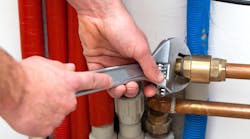Five years ago, I visited a home to find out why they were not able to maintain 68°F during colder weather. Hot water baseboard was installed on the upper floor with radiant tubing embedded in concrete for the daylight basement area. An 80,000-Btuh modulating condensing boiler with a twisted-sister attempt at primary/secondary piping, no thermal mixing for the radiant zone, and an indirect water heater feeding into a live electric water heater.
The venting was PVC and discolored due to the fact that no outdoor sensor was installed, therefore no outdoor reset, and the boiler was bouncing off of its 195°F limit! No condensing for that modcon. The installer was bankrupt and no longer in business.
Schedule 40 PVC is rated for 140°F maximum and at 180°F/195°F (the programmed range the installer used), the vent line was discolored due to exceeding its temperature limitation. A manual-J calculation revealed the home had an 112,000-Btuh heat loss when it was 13°F outdoors (default ASHRAE design day for our area).
They did not like my price. A month ago, they called again... You know I had to go: like a moth to a flame! The second installer was also bankrupt and out of business. Installer No. 2 had corrected the primary/secondary piping and added mixing for the radiant zone. A second 80,000-Btuh modcon had been added. Once again, no outdoor sensors, so no outdoor reset, and now both boilers were being run as one and both were bouncing off their 195°F limit!
The old 80K modcon’s Giannoni (looks like a slinky laid on its side) heat exchanger had sprung a leak while the second, now five-years-old boiler, was clogged with combustion debris and on hard-lockout. Back to square one with not enough heat! Both PVC exhaust lines were heat-discolored. The homeowner explained that they felt our price five years ago was too high and went with the lower price.
Shortly after the installation, the new PVC exhaust vent had fallen apart because the installer had forgotten to solvent-weld the fittings. Their CO detector went off. It was also obvious no combustion analysis had been conducted, as no holes were present in the PVC exhaust on the newer modcon.
They wanted both of their 80K modcons repaired and they were mildly interested in outdoor reset. I reluctantly agreed to check on the parts cost, but knew we weren’t about to actually do the work. My intent was to ascertain the costs for repairing both boilers and then quote the installation of a new modcon with a fire-tube style low head loss heat exchanger.
Fortunately, I had their Manual-J heat loss calculation and the room-by-room live baseboard (tube with fins), so that we could properly program an outdoor reset curve. For example, take a room with a 5,000-Btuh heat loss at design day conditions with 20’ of “live” Slant Fin Fine Line 30 ¾” copper fin-tube baseboard. That equals 250-Btuh required per foot of baseboard. Checking Slant Fin’s chart for this baseboard reveals our hottest water temperature required is slightly below 130°F: perfect for utilizing a modcon and the outdoor reset curve could be set to operate from 110°F to 130°F. Truth be told, we’ll actually set it to operate between 90°F and 130°F if the homeowners are willing to experiment with water temperatures below what is listed on the chart.
http://www.slantfin.com/images/stories/Technical-Literature/ratings_fineline30_r.pdf
Back to the PVC venting issue: My own at-home experiments conducted over the past two decades and a virtual parade of modcon boilers revealed that the exhaust temperature is a fairly constant 10°F above the outgoing boiler supply-water temperature. That means this home’s twinned modcon vents were seeing an average of 190°F/205°F every time the boilers ran. Because they are oversized for the home’s 112K heat loss at design day conditions, they will hit the 195°F limit before the zones can be satisfied.
Once again, I was told our price was too high. I wished them luck and assumed I’d see them again in five years. A few months passed when their name popped up in my e-mail. Was I willing to match someone else with a lower price? No.
More time passed and they once again e-mailed to say they did their own online research and found a lower-priced modcon boiler. Was I willing to install that model? Before answering, I did my own online research and discovered the model they had chosen had a Giannoni-style heat exchanger. Rather than simply say no, I gave them a side-by-side comparison to illustrate why the modcon boiler I had suggested was far superior and required less annual maintenance. Knowing their twinned boilers had never been given an annual cleaning, I included cost projections for annual maintenance on both boilers. I ended my message by saying I was not interested in being their installer if they wanted to repeat history with a Giannoni heat exchanger.
Another month of silence passed by, and I assumed they had gone with the cheaper boiler/contractor. Yesterday I received an e-mail asking us to install the better boiler. “How soon can you start?”
New PVC will be OK for venting due to incorporating outdoor reset and running exhaust temperatures below the high-limit-temperature of 140°F. We often use polypropylene, which has a high temperature limit of 230°F. If you haven’t tried polypropylene, check out the flexible chimney liner kits for that next modcon or high efficiency tankless water heater installation (not all manufacturers have accepted polypropylene yet) where sidewall venting is not easily available and they have what is about to become an unused chimney.
All Dave Yates material in print and on Contractor's Website is protected by Copyright 2014. Any reuse of this material (print or electronic) must first have the expressed written permission of Dave Yates and Contractor magazine. Please contact via email at: [email protected].


